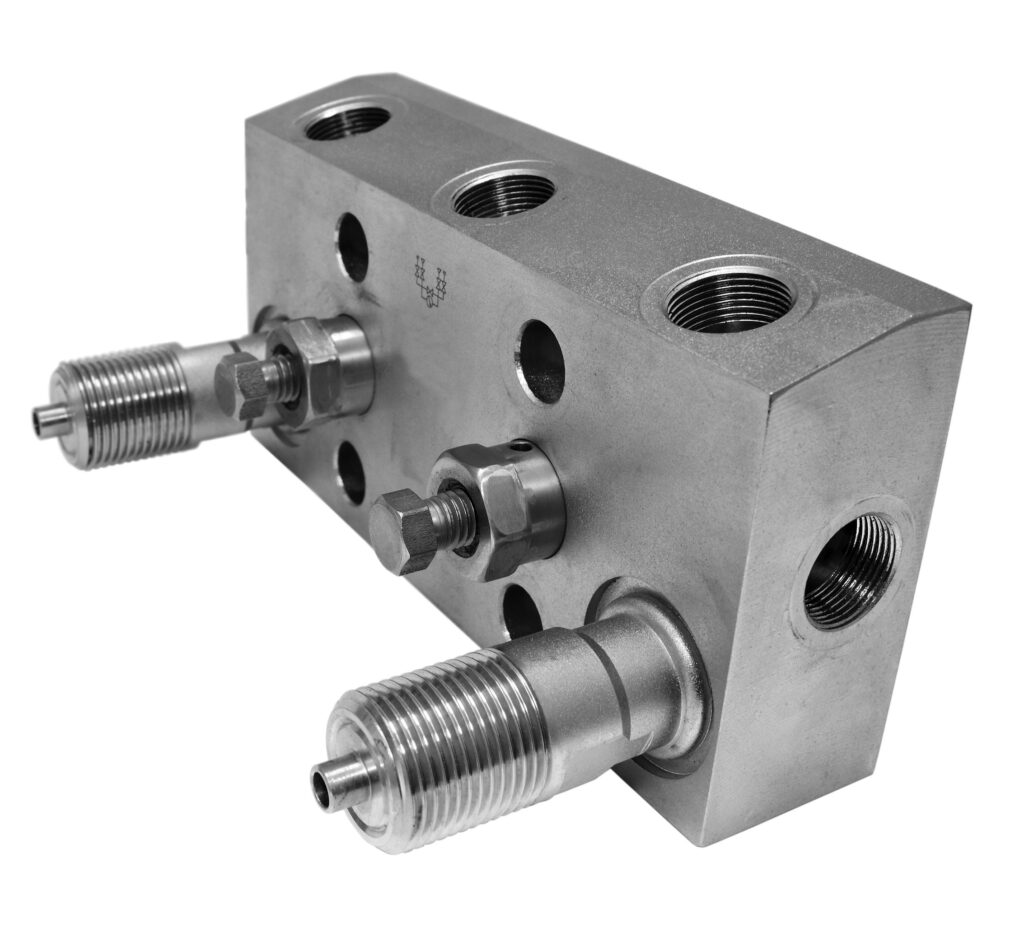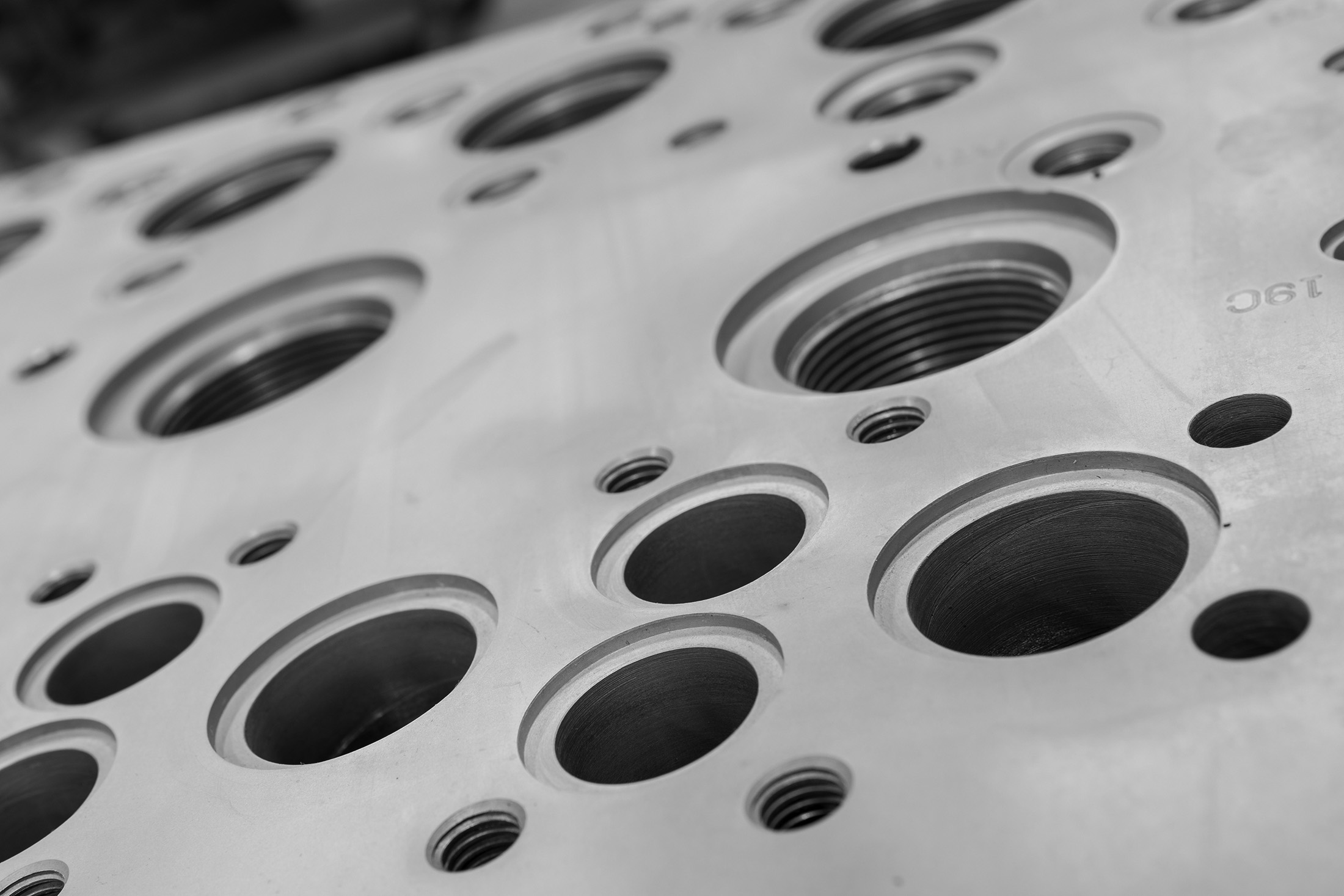
Accuracy is vital when manufacturing manifolds for assembly into automotive engines, hydraulic systems, pneumatic systems, medical devices and other fluid and air delivery systems. Machining manifolds requires specialized techniques and equipment to produce precise parts requiring high tolerances. Nolte Precise Manufacturing uses the CNC horizontal machines that revolutionized the manifold machining process and ultimately transformed the manufacturing landscape in the following ways:
1. Manufacturing Manifolds with Enhanced Precision
CNC horizontal machines are known for their exceptional precision to ensure proper fluid flow, airtight seals, and optimal performance. These machines can achieve high levels of accuracy, allowing for tight tolerances and intricate designs. Potential tolerances ranges in terms of manufacturing manifolds include:
- Dimensional Tolerances: CNC machines can typically achieve dimensional tolerances in the range of ±0.01 mm to ±0.05 mm (10 μm to 50 μm) for critical dimensions of the manifold. This level of precision ensures that the part fits precisely with other components in the system.
- Surface Finish Tolerances: CNC machines can achieve surface roughness tolerances in the range of Ra 0.4 μm to Ra 1.6 μm. This level of surface finish ensures that the manifold’s sealing surfaces are smooth, preventing fluid leaks and ensuring optimal performance.
- Positional Tolerances: For features that require precise positioning, CNC machines can achieve positional tolerances in the range of ±0.05 mm to ±0.1 mm (50 μm to 100 μm). This accuracy is crucial for mounting holes, alignment features, and sensor placements when manufacturing manifolds.
- Angular Tolerances: CNC machines with multi-axis capabilities can achieve angular tolerances in the range of ±0.1 degrees to ±0.5 degrees. This precision is essential for creating complex geometries and ensuring the correct alignment of fluid passages.
The precise control offered by CNC machining reduces the chances of errors and ensures consistent results, even for complex manifold configurations.
2. Increased Productivity
The CNC horizontal machine boasts impressive speed and efficiency, resulting in increased productivity. With the ability to perform multiple operations in a single setup, these machines streamline the manufacturing process. Manifold machining involves various tasks such as drilling, milling, tapping, and threading, which can be seamlessly executed on a CNC horizontal machine. The Parts Per Minute (PPM) varies depending on the complexity of the part. For more complex manifolds that involve intricate geometries and multiple machining operations, the average PPM may decrease to 1 or even less than 1 part per minute. These parts may require longer machining times per piece due to the complexity of the design and the need for precision on each operation. For more simple procedures, CNC machines can achieve as many as 10 PPM or more. It is important to consider achieving lower PPMs to maintain higher accuracy and quality. The automated nature of these machines reduces manual intervention, minimizing downtime and maximizing production output.
3.Versatility and Flexibility
CNC horizontal machines offer remarkable versatility, accommodating a wide range of manifold designs and materials. Whether it’s aluminum, steel, or other metals, these machines can handle different materials with ease. Additionally, the flexibility of CNC programming enables quick changes and adjustments, allowing manufacturers to adapt to evolving design requirements or customer preferences. CNC horizontal machines save anywhere from 20% to 80% of manufacturing time depending on the type of parts machined. Time savings are achieved through optimizing setup times, automatically changing tools, incorporating batch processing, performing precise and consistent adjustments, and maintain continuous operation. This versatility translates into shorter lead times, making CNC horizontal machines a preferred choice for manifold production.
4. Manufacturing Manifolds with Improved Surface Finish and Quality
Manifolds often require smooth internal surfaces to minimize friction and maximize fluid or gas flow. CNC horizontal machines excel in providing excellent surface finishes. The precise cutting tools, along with the machine’s rigidity, ensure consistent quality and exceptional surface smoothness. This high-quality finish not only enhances the performance of the manifold but also contributes to its durability and longevity.
Producing superior surface finishes on different metals on CNC horizontal machines requires careful control of cutting parameters, including temperature, to avoid issues such as thermal deformation, tool wear, and surface roughness. The optimal temperature ranges for machining various metals can vary based on the specific metal’s properties, cutting tools, and machining conditions. Here are some general temperature guidelines for machining common metals:
Aluminum
- Cutting Temperature Range: 200°C to 400°C (392°F to 752°F)
- Aluminum has good thermal conductivity, so it tends to dissipate heat quickly during machining. To achieve superior surface finishes, it’s essential to maintain moderate cutting temperatures to prevent built-up edge and smearing.
Stainless Steel (e.g., 304, 316)
- Cutting Temperature Range: 200°C to 600°C (392°F to 1112°F)
- Stainless steel is more challenging to machine due to its low thermal conductivity. To achieve superior surface finishes, it is crucial to avoid excessive temperatures that can lead to work hardening and accelerated tool wear.
Carbon Steel
- Cutting Temperature Range: 300°C to 600°C (572°F to 1112°F)
- Carbon steel can tolerate slightly higher cutting temperatures compared to stainless steel. Controlling temperatures within this range helps prevent work hardening and minimizes tool wear, leading to better surface finishes.
Titanium
- Cutting Temperature Range: 600°C to 800°C (1112°F to 1472°F)
- Titanium is known for its low thermal conductivity and a tendency to react with cutting tool materials at elevated temperatures. Maintaining moderate cutting temperatures is crucial to avoid built-up edge and maintain surface finish quality.
Brass and Copper
- Cutting Temperature Range: 200°C to 350°C (392°F to 662°F)
- Brass and copper have good thermal conductivity and can dissipate heat efficiently. Controlling temperatures within this range helps achieve excellent surface finishes without excessive tool wear.
Cast Iron
- Cutting Temperature Range: 300°C to 600°C (572°F to 1112°F)
- Cast iron is a relatively soft metal, but it can generate high cutting temperatures due to its abrasive nature. Careful temperature control is necessary to avoid thermal damage to the cutting tool and achieve superior surface finishes.
It’s important to note that these temperature ranges are general guidelines and can vary based on factors such as cutting speed, feed rate, coolant type, and the specific grade of the metal being machined. Experienced machinists monitor cutting temperatures using appropriate tools and adjust cutting parameters as needed to achieve the best surface finishes without compromising tool life and workpiece integrity. Additionally, using advanced cooling techniques, such as high-pressure coolant, can help manage temperatures during machining, further enhancing surface finish quality when it comes to manufacturing manifolds or other precision parts.
5. Cost-Effective Solution
Although CNC horizontal machines may involve a higher upfront investment, they prove to be cost-effective in the long run. The automation and efficiency they offer reduce labor costs and minimize material waste. Moreover, the accuracy and reliability of CNC machining eliminate the need for rework or scrap, saving both time and money. The increased productivity and shorter lead times also contribute to overall cost savings and improved profitability.
Final assembly of manifolds must be exact to form the necessary liquid- and gas-tight seals needed to function properly. The advantages of machining manifolds on CNC horizontal machines are clear: enhanced precision, increased productivity, versatility, improved surface finish, and cost-effectiveness. These machines using milling, drilling, turning and routing tools have transformed the manifold manufacturing process, offering manufacturers the ability to produce high-quality, complex components efficiently. As the manufacturing industry continues to evolve, CNC horizontal machines will undoubtedly play a crucial role in meeting the growing demands for precision and efficiency in manifold production. Learn more about how Nolte Precise Manufacturing works with customers to deliver consistent and accurate manifolds to meet their exact requirements.

